
By Jim Dunn, Professor of Agricultural Economics, Penn State University Market Psychology
Dairy prices have fallen in the past month, especially butter prices. The dollar is still strong, with the Euro dropping to its lowest level in several years. Europe's economies are stagnant, notably Greece, which is having trouble meeting its agreement with the European Central Bank to satisfy the deal that accompanied its bailout. The other struggling economies in the European Union are not doing well either, and with falling commodity prices and effect of the Russian sanctions.
President François Hollande of France spoke recently about reducing the Russian sanctions. U.S. dairy exports continue to be weak, although the New Zealand dollar has stabilized versus the greenback. In addition to fewer exports, milk production continues to grow.
Butter prices have dropped by 22% since last month, from $1.985 to $1.54/lb. This drop happened suddenly in mid-December and the butter price has been steady since. Over the same period, block cheese prices have moved around, but are only one cent lower than a month ago, at $1.57/lb. The skim-milk powder price fell by 8% (8.5¢/lb.) but has recovered somewhat lately. The dry whey price is down 3% since last month. Although butter prices weakened in December, most of the product prices have been steady at the recent lower levels.
Table 1 lists some past and estimated future milk prices. The December Pennsylvania all-milk price fell by $2.70/cwt. from November to $21.60/cwt. The growth in milk production growth continues to be high, and the futures market has lower prices for Class III and IV for 2015.
The December Class III price was down $4.12 from November at $17.82/cwt. The latest Class III futures prices for the first half of 2015 average $15.02, showing Class III milk prices continuing to fall through April, with higher prices for the remainder of 2015. The average Class III futures prices for all of 2015 are $15.66. The December Class IV price was down $1.51/cwt. from November at $16.70/cwt. My forecast all-milk prices for the 2015 average $18.77/cwt., or $6.79/cwt. below 2014.
The U.S. dollar is up against the Euro and the Australian dollars since my last report, with the New Zealand dollar up slightly. The dollar is up 0.6% against the Euro. The dollar has risen 29% against the Aussie dollar in two years, a very large change in exchange rates.
Australia is struggling with weakness in the Chinese economy. According to the Wall Street Journal, the dollar has risen by 13% against the euro and 15% against the yen since the end of June. These are very large changes for exchange rates and since the U.S. is a major exporter of most agricultural commodities, this will adversely affect most farm prices as U.S. products become less affordable than its competitors
Corn and Soybean Markets
Corn prices have risen 7% since the last report, ending at $4.05/bu. for the March 2015 corn contract. Part of that is the added storage cost for a later delivery month and the rest is the effect of minor changes in supply and demand. Soybean meal has been oscillating in a narrow range and is at $368.50 for January meal.
Soybean prices are up 0.7% from last month. At this stage there is not much news on these markets, since the U.S. crops are harvested and next year's crop is still in the distant future. Weather in South America and exports are the only major news.
Income over Feed Costs (IOFC)
Penn State's measure of income over feed costs fell by 19% in December, with milk prices down and feed prices up. Figure 1 shows how these values compare to recent years. December's feed cost is 33¢/cow/day more than in November.
November's value for IOFC of $8.80/cow/day is 19% below the November value of $10.89. The PA all-milk price was down $2.70/cwt. in December, while the feed costs rose by 7%, with higher prices for corn, soybean meal and hay. Income over feed cost reflects daily gross milk income less feed costs for an average cow producing 65 pounds of milk per day. Figure 1 and Table 2 showing the monthly data follow.
The allocation of the revenue per hundred pounds of milk is shown in Table 3. The milk margin is the estimated amount from the Pennsylvania all milk price that remains after feed costs are paid. Like income over feed cost, this measure shows that the November PA milk margin was 19% below November.
Milk Production
The latest milk production report showed November milk production up 3.4% from the year earlier, another sizeable monthly increase after many months of minimal growth (Figure 2). This is bearish, although the increase was expected. Once again, the growth in milk production was in milk per cow rather than cow numbers. The national dairy herd this November is only 0.89% greater than in November 2013. The monthly cow numbers is shown in Figure 3.
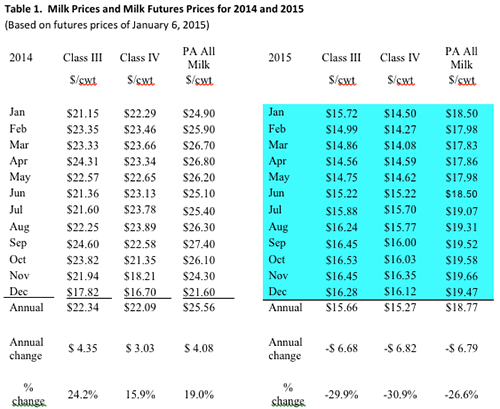
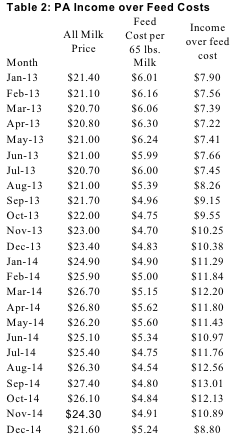
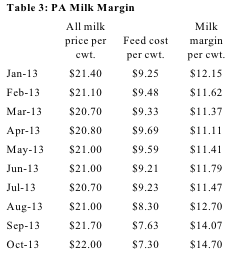
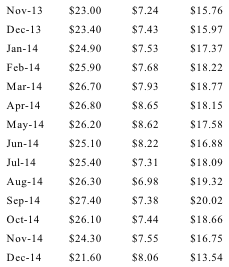
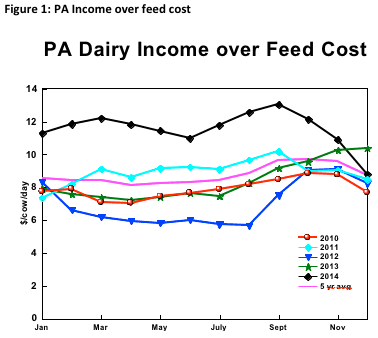
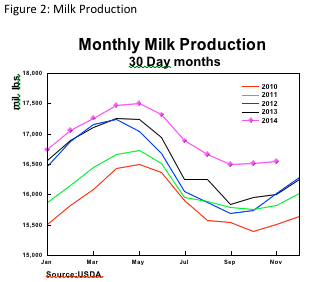

1.9.2015